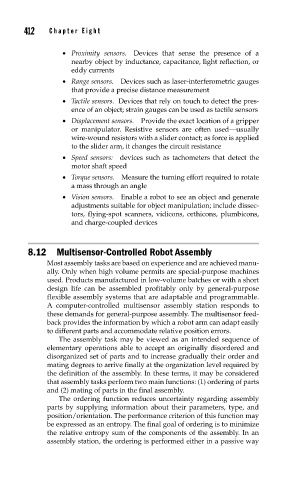Page 459 - Sensors and Control Systems in Manufacturing
P. 459
412
Ei g h t
Cha p te r
• Proximity sensors. Devices that sense the presence of a
nearby object by inductance, capacitance, light reflection, or
eddy currents
• Range sensors. Devices such as laser-interferometric gauges
that provide a precise distance measurement
• Tactile sensors. Devices that rely on touch to detect the pres-
ence of an object; strain gauges can be used as tactile sensors
• Displacement sensors. Provide the exact location of a gripper
or manipulator. Resistive sensors are often used—usually
wire-wound resistors with a slider contact; as force is applied
to the slider arm, it changes the circuit resistance
• Speed sensors: devices such as tachometers that detect the
motor shaft speed
• Torque sensors. Measure the turning effort required to rotate
a mass through an angle
• Vision sensors. Enable a robot to see an object and generate
adjustments suitable for object manipulation; include dissec-
tors, flying-spot scanners, vidicons, orthicons, plumbicons,
and charge-coupled devices
8.12 Multisensor-Controlled Robot Assembly
Most assembly tasks are based on experience and are achieved manu-
ally. Only when high volume permits are special-purpose machines
used. Products manufactured in low-volume batches or with a short
design life can be assembled profitably only by general-purpose
flexible assembly systems that are adaptable and programmable.
A computer-controlled multisensor assembly station responds to
these demands for general-purpose assembly. The multisensor feed-
back provides the information by which a robot arm can adapt easily
to different parts and accommodate relative position errors.
The assembly task may be viewed as an intended sequence of
elementary operations able to accept an originally disordered and
disorganized set of parts and to increase gradually their order and
mating degrees to arrive finally at the organization level required by
the definition of the assembly. In these terms, it may be considered
that assembly tasks perform two main functions: (1) ordering of parts
and (2) mating of parts in the final assembly.
The ordering function reduces uncertainty regarding assembly
parts by supplying information about their parameters, type, and
position/orientation. The performance criterion of this function may
be expressed as an entropy. The final goal of ordering is to minimize
the relative entropy sum of the components of the assembly. In an
assembly station, the ordering is performed either in a passive way

